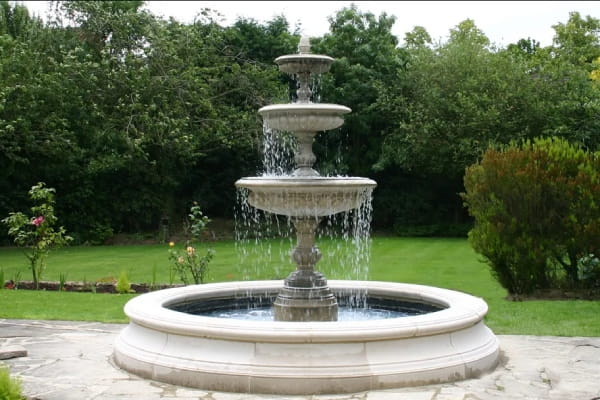How To Paint A Fountain Professionally [10 Infallible Tips]
Fountains are a stunning addition to any garden or outdoor space. They can dramatically transform a simple garden into a very lovely one.
However, like other outdoor structures, fountains need to be regularly maintained and repaired to ensure they continue to look attractive. Painting is a crucial part of keeping a fountain attractive.
Although painting a fountain might not seem like much, it is essential to keep the structure appealing. A professionally painted fountain not only improves its aesthetic value but also serves as a protective barrier against the weather.
The paint on a fountain can fade, flake, and break after being exposed to the elements for an extended period of time that’s why we have created this blog post to show you how to paint a fountain professionally in order to prevent fading or flaking.
But before we proceed, let’s take a deeper look at why you need to paint your fountain professionally.
Why you need to paint your fountain professionally
Here are the reasons you should consider painting your fountain professionally.
Charming Appearance
The obvious goal of painting a fountain professionally is to make it more attractive.
You know, with expert painting, your fountain’s original colour and lustre can be restored, making it appear as good as new.
Protection from harsh weather
Outdoor fountains are expose to harsh weather conditions, including rain, sun, and wind.
The paint on the fountain could eventually peel off due to extreme temperatures and humidity outside. However, you can keep your fountain in pristine condition by having it professionally painted.
Paints and coatings used by professionals are of the highest quality and are made to withstand the elements for an extended period of time.
Prevention of structural damage
Painting your fountain professional will not only make your fountain look better but will also protect it from wear and tear.
Painting the fountain protects it from moisture and other environmental hazards like rust and corrosion.
Without painting, water can leak into the fountain’s cracks and crevices, weakening its structure and shortening its longevity.
Choosing the right paint for painting a fountain professionally
Painting a fountain professionally involves several considerations, the least of which is the paint you use.
Your fountain can be protected from the elements and look its best with the appropriate paint, while the wrong paint could do more harm than good.
Here, we’ll go over what you need to know to pick the best paint for a professional painting.
Type of material use for the fountain
Materials use for constructing the fountain should be your first consideration when picking a paint.
Different fountain materials require different type of paint. It would be inappropriate to use a paint meant for concrete fountain on a metal fountain.
In order to get the best possible adhesion and longevity, the paint you use must be suitable for the material your fountain is made of.
Paint type
Your fountain’s needs will determine which paint is best, as each has advantages and disadvantages.
For instance, oil-based paints are long-lasting and cover well, but they take longer to dry and give out toxic fumes.
In contrast, latex paints may be applied and cleaned off quickly, but they may not last as long as oil-based paints. Epoxy paints last longer than oil base and latex but they very expensive.
Resistant to harsh weather
The paint on your fountain can fade, peel, or break since it is constantly exposed to the elements, including the sun, rain, wind, and snow.
That’s why it’s crucial to select paint that won’t chip or peel when exposed to the environment. Use paints that can withstand the elements without fading, chalking, or peeling.
Safety and Environmental Impact
When selecting paint for your fountain, you should also think about its potential hazards and its effect on the environment.
Try to use paints that do not emit dangerous chemicals and can be touched by both humans and pets. Consider using environmentally friendly paints as well.
Types of fountains and paints
As earlier said, fountains offer a touch of class and sophistication to any garden, courtyard, or outdoor space, whether they belong to a private residence, a public park, or a business.
There are a wide range of fountains available, from the classical to the contemporary, each with its own design.
In this section, we will take a look at the differeny types of fountains and the type of paint you can use on them.
Concrete Fountains
The price and longevity of concrete fountains make them a popular option. Concrete fountains are made of reinforced concrete and this allows them to be formed into any desired shape.
If you are considering painting a concrete fountain, do choose acrylic paint because it is the best for painting concrete fountains.
Acrylic paint is frequently used to paint concrete fountains because of its adaptability, longevity, and resistance to harsh weather conditions.
Acrylic paint is quick to dry. It’s non-toxic, and being simple to clean up after use. It is not only weatherproof but also resistant to cracking and peeling, making it perfect for use on concrete fountains.
Acrylic paint is available in a broad variety of colours and finishes, such as glossy and matte, so you may find the perfect one for your project.
Stone Fountains
Stone fountains are a classic choice that can elevate the look of any outdoor space. Marble, granite, and limestone are just a few of the stones that can be used to create them.
Epoxy paint is the best option for refinishing stone fountains. When applied properly, epoxy paint forms a tough, watertight coating that can tolerate prolonged contact with liquid.
It can withstand the elements without deteriorating or becoming unattractive. Epoxy paint has a high-gloss finish that can make your fountain look even more stunning, but it only comes in a small selection of colours and sheens.
Metal fountain
The contemporary and chic appearance of metal fountains makes them a popular option. Stainless steel, copper, and bronze are just a few of the metals that can be used in making metal fountains.
If you have a metal fountain and want to paint it Professionally, go for urethane paint.
Urethane paint produces a durable, glossy finish that is resistant to the elements, chemicals, and UV radiation. It can also withstand the elements without deteriorating or becoming unattractive.
Urethane paint offers a durable coating that will safeguard your fountain for years, but it is only available in a small selection of colours and sheens just like epoxy paint.
Wall Fountains
If you have limited space in your backyard but still need a fountain, wall fountain is the type of fountain you should go for.
Wall fountains are a space-saving option that makes your outdoor space stylish. Wall fountains can be made from various materials like stone, metals etc.
Latex paint is the best option for wall fountains. Latex paint, being water-based, offers both excellent coverage and simple cleanup.
Latex paint dries quickly and resists fading, cracking, and peeling. It’s available in different colours and a selection of sheen levels, from glossy to matte.
Latex paint, on the other hand, may not be as long-lasting as oil-based paints and may require additional touch-ups more frequently.
Tiered fountain
A tiered fountain is another elegant addition to any outdoor setting. They often consist of several layers, with water tumbling from the highest to the lowest. Tiered fountains are best painted with oil-based paint.
Due to its longevity and coverage, oil-based paint has long been the best paint for tiered fountains. Painting your tiered fountain with oil-based paint will give it a glossy, uniform sheen that will disguise flaws and highlight its natural charm.
It is not only weatherproof but also resistant to cracking and peeling, making it perfect for outdoor use. However, oil-based paint requires solvents for cleanup, takes longer to cure, and gives off toxic smells.
Resin fountain
Indoor and outdoor spaces alike benefit from the addition of a resin fountain. These fountains are constructed from a wide range of materials, including resin, and are available in a wide range of sizes and designs.
Resin fountains are advantageous since they are portable, long-lasting, and resistant to the elements. They are durable enough to resist the weather without deteriorating, making them great for use in the great outdoors.
If you have a resin fountain and want it to last for years, you have to choose right kind of paint because if you paint a resin fountain using a paint that isn’t made for it, the finish may peel or chip over time.
Look for a paint that is made to be used on plastic or resin surfaces if you plan on painting your resin fountain. These paints generally include specific additives that will make it attach better to the surface and produce a lasting finish,
Spray paint is frequently used to painting resin fountains. Spray paint comes in a wide range of colours and textures, from metallic to matte to glossy, and is incredibly user-friendly.
Acrylic paint is another alternative for painting resin fountains. Acrylic paints are water-based, multipurpose paints that may be applied to a wide variety of substrates, including resin.
Now that you have known the types of fountains and the paints you can use for each of them, let’s quickly look at professional tips you can use to achieve a smooth finishing.
Tips to achieve a smooth painting
Here are tips you can use to get a professional results while painting your fountain;
Use a primer
Priming the surface before painting improves paint coverage and helps prevent peeling. Choose a primer that works with the paint you intend to use.
Sand the surface
Lightly sand any rough or uneven areas of the fountain’s surface before painting. The paint will stick better and the surface will be smoother if you do this first.
Apply thin coats
Rather than using one heavy coat of paint, apply several thin coat. As a result, you’ll have less trouble avoiding drips and getting a nice, even coating.
Allow each coat to dry
It’s important to wait for each layer of paint to dry before adding a new one. This way, the paint won’t be able to peel or flake off as easily.
Use a paint sprayer
Instead of using a brush or roller, invest in a paint sprayer for a more professional finishing. It also facilitates the application of paint in very thin layers.
Apply in a dust-free environment
If you paint the fountain in a clean, dust-free environment, the surface won’t collect dirt and dust while it dries.
Use proper technique
Whether you prefer to paint in straight lines, a crisscross pattern, or a combination of both, it’s important to use a style that works well for you.
If you don’t want brush marks or streaks, try to avoid painting in circles or employing a back-and-forth motion.
Seal the surface
Apply a clear coat or sealer to the surface of the fountain once the paint has dried to protect it and give it a shiny appearance.
Tools for painting a fountain professionally
Here are tools you will need in painting your fountain professionally;
- Paintbrushes
- Paint rollers
- Paint sprayer
- Sandpaper
- Drop cloths
- Painter’s tape
- Paint scraper
- Paint tray
- Paint thinner
- Cleaning brushes
- Primer
- Paint
- Clear coat or sealer
- Dust mask
- Safety goggles
How to paint a fountain professionally
DIY fountain painting can be a lot of fun, but it takes careful planning and practise to get a professional look. To paint your fountain like a professional, follow these steps:
Choose Your Paint and Tools
The first step in making a fountain is picking out the appropriate paint and tools. Paint that is made to adhere to plastic should be used on a resin fountain.
Use outdoor paint that can withstand the elements and is of good quality. Paint, a paint roller, sandpaper, painter’s tape, a drop cloth, and a cleaning brush are the basic tools you will need.
Prepare the Fountain
You need to get the surface of your fountain ready for painting first. Scrub away the grime and garbage with a cleaning brush and some mild detergent.
Give the fountain a good rinsing and dry it out with water. Then, smoothen the fountain’s exterior with fine-grit sandpaper. The paint will stick better to it, and the result will be nice and even.
Tape and cover
The next step is to cover the area you do not want to paint such as the fountain’s pump and electrical parts with painter’s tape. Also, use a drop cloth or plastic sheeting to shield the ground below from overspray and drips.
Apply primer
Applying a primer to the fountain’s surface is a necessary first step before painting. The paint will stick better and the result will last longer if you do this.
Apply a primer coat to the fountain with a paintbrush or roller, making sure to cover the surface evenly. Wait until the primer has dried completely before proceeding.
Apply your desired paint
Apply paint to the fountain with a paintbrush or roller in a thin, equal coat. Start at the top of the fountain and work your way down in manageable chunks.
Avoid brush smears and drips by using long, even strokes. Don’t apply another layer of paint until the first one has fully dried.
Seal the paint
After you’ve applied the last coat of paint, it needs to be sealed so it doesn’t deteriorate over time.
Seal the surface of the fountain with a transparent, weather-resistant sealant. Use a paintbrush or sprayer to apply the sealer in light, equal coats. Do not touch the fountain until the sealant has dried completely.
Remove the tape and clean
Carefully take away the painter’s tape and drop cloth when the sealer has dried. Use water or paint thinner to clean your brushes and tools, and then let them dry completely before putting them away.
Conclusion
There you have it, a complete guide on how to paint a fountain professionally. You know, painting a fountain can be a fun and gratifying experience.
Whether you’re seeking to clean up your garden, create a distinctive centrepiece for your outdoor space, if you take the time to properly prepare the surface, select high-quality paint and tools, and then follow the steps in this blog post, you will have a fountain that is the envy of the neighbourhood.
FAQs
Yes, sanding the surface of your fountain before painting will improve paint adhesion and give a more uniform finishing.
Two to three thin coat is recommended but you have to wait for each coat to dry before adding another.
Yes. Sealing the paint after you’ve painted your fountain is a must if you want the finishing to last as long as possible and withstand harsh weather conditions.


![Wiring an Outdoor Water Fountain – [Safe DIY Guide]](https://pondmemo.com/wp-content/uploads/2023/08/wiring-an-outdoor-water-fountain-IMG_1.jpg)

![Here’s Why Your Fountain Loses Water [9 Reasons & Quick Fix]](https://pondmemo.com/wp-content/uploads/2023/11/why-your-fountain-loses-water-IMG_1.jpg)
![Keeping Bees Away from a Fountain [Practical Guide]](https://pondmemo.com/wp-content/uploads/2023/08/keeping-bees-away-from-a-fountain-IMG_1.jpg)
